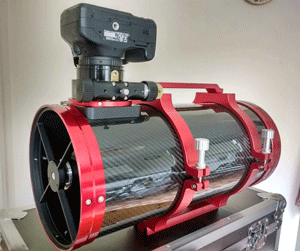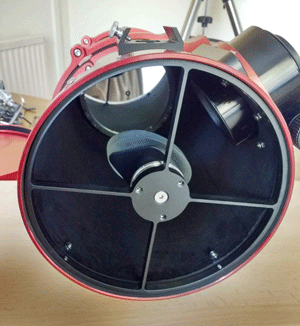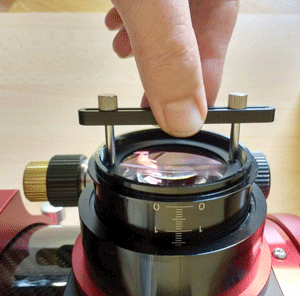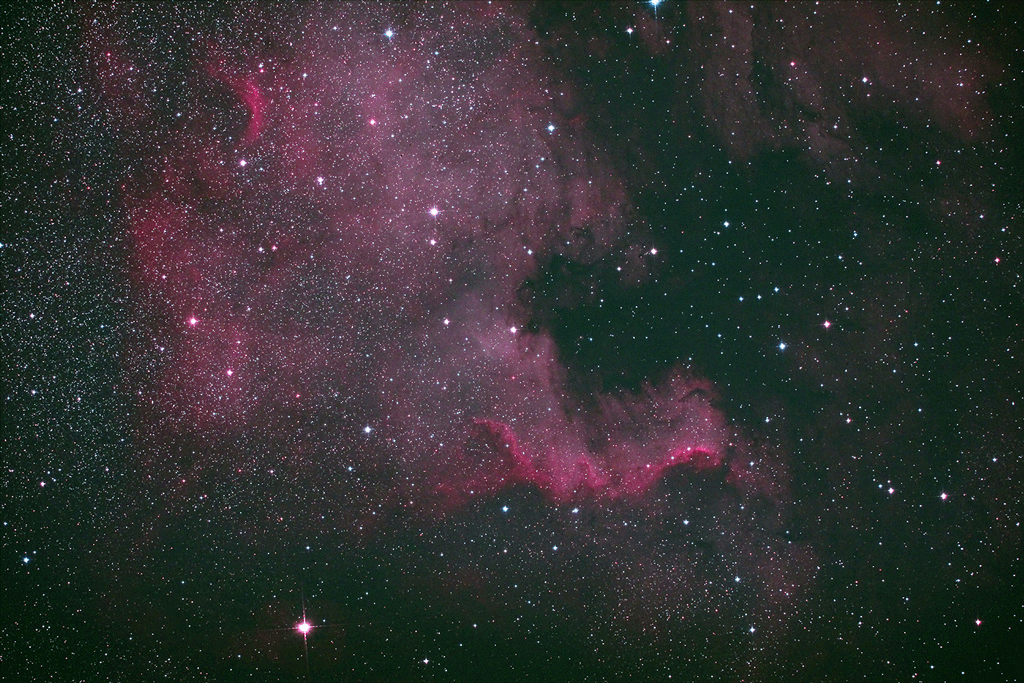
Until comparatively recently, if you wanted to capture extended deep-sky objects such as diffuse emission nebulae and supernova remnants with your full-frame DSLR or CCD/CMOS camera, then your best option was to invest in an f/2 or f/2.8 telephoto prime lens from one of the big-name players in photography. Such high-precision solutions possess multi-element lenses, often made of exotic glass, and sometimes with aspheric shapes designed to ensure tight control of false colour, off-axis aberrations and field curvature over a large imaging sensor. Not surprisingly, lenses possessing these desirable characteristics don’t come cheap. For example, a Nikon 200mm, f/2 G ED AF-S Nikkor VR II or Canon EF 200mm, f/2 L IS USM will each lighten your bank balance by more than £5,000.
While f/2 and f/2.8 prime lenses can record bright nebulae and galaxies in minute-long exposures at the high ISO sensitivities of modern DSLRs, 200 and 300mm focal-length lenses are too short to reveal fine detail in small-scale examples of these deep-sky objects, unless one is prepared to use one of the new breed of cameras employing CMOS sensors with tiny (less than 2.5 micron) pixels. Even so, most astro-imagers would prefer focal lengths of at least 400 to 500mm to ensure optimal pixel sampling, at which point one balks at the astronomical cost of prime camera lenses meeting those specifications. Fortunately, there are catadioptric – that is, optical instruments employing both lenses and mirrors to form an image – alternatives that are much cheaper, one of which is the 150mm aperture, 420mm focal length, f/2.8 SharpStar hyperboloid Newtonian profiled here.

Delivery and first impressions
It’s a truism that you never get a second chance at a first impression, but few will forget the first time they set eyes on the SharpStar D 150mm, f/2.8 HNT, hereafter called the HNT (Hyperboloid Newtonian Telescope) from Jiaxing Ruixing Optical Instrument Co., Ltd in China, trading as SharpStar Optics. From the moment you release the latches on the professional looking – and very practical, I might add – 60 × 30 × 35 centimetre flight case and lift the lid, you’re struck by the undeniable beauty of the HNT. It’s no exaggeration that the unboxing experience was on a par with any high-end optical instrument from all the big-name players that I’ve reviewed to date. The HNT on an equatorial mount in the corner of any room invites covetous glances and will guarantee an admiring crowd at your astronomical society meeting.
Few will forget the first time they set eyes on the SharpStar D 150mm, f/2.8 HNT
The eye-catching black carbon-fibre tube and red, anodised CNC aluminium fixtures and fittings lend the HNT the air of a professional, high-precision instrument. It’s not all style and no substance though; these initial impressions bear up under closer scrutiny. The HNT shows well-conceived design and attention to small detail. For example, all of the review instrument’s external Allen-head-domed bolts are made of corrosion-resistant stainless steel. Similarly, the primary mirror’s collimation thumbscrews are recessed in the rear cell, so that the optical tube assembly (OTA) can stand flush on any flat surface. While the carbon-fibre tube has a diameter of 195mm, the fore and aft red anodised end cells are 200mm in diameter. The overall tube length (with snug-fitting CNC dust cap removed) is 450mm. Sans camera but including anodised tube rings, carry handle and Vixen dovetail, the OTA tips the scales at a mere 5.3 kilograms.

Although no finder is supplied, there is a Vixen-style shoe for an optical, red dot or finder-guider of your choice. The robust tube rings are tapped and threaded top and bottom, not only for both 20-centimetre-long Losmandy- or Vixen-style dovetail mounting bars (both supplied with the telescope) and an ergonomic carry handle (with an integral piggyback rail for a DSLR camera), but also for a larger guidescope’s mounting rings, if required. The low profile 2.5-inch rack and pinion focuser has 30mm of travel with dual-speed coarse and fine focus adjustments, while the cross-shaped four-vane spider and secondary mirror mount is CNC machined from a solid piece of aluminium, for rigidity and stability. Furthermore, the 70mm minor axis elliptical flat is cemented to a holder with the correct 5mm offset that has been set at the factory for the f/2.8 focal ratio. The primary has a full aperture mask with no mirror clips, hence the only diffraction effects in the optical train arise from the 2mm-thick spider vanes. The tube is completely flocked to suppress any internal light scatter.
Hyperbolic hype, or a revolution in imaging?
Anyone with more than a passing interest in optics will be familiar with the names and properties of the solid geometry curves used in the design of telescope lenses and mirrors, even if their definitions are lost in dimly recalled maths lessons about graphs and quadratic equations. While it’s possible to fabricate a high-performance instrument such as a catadioptric Maksutov–Cassegrain using optical surfaces based on simple spheres that can be mass produced, the resulting telescope usually has a large focal ratio of f/10 to f/15. (The focal ratio is the focal length of the instrument divided by its aperture. Hence a 75mm diameter lens or mirror that forms an image of distant objects 900mm away has a focal ratio of 900 ÷ 75 = 12, usually written as f/12.)

As stated in the introduction to this review, any photographer knows that large focal ratios are inherently ‘slow’, meaning that frustratingly long exposures are required to capture images of extended objects like nebulae and galaxies. We’ve also seen that large and optically ‘fast’ lenses of small focal ratio – f/2 or f/2.8 – can be prohibitively expensive. At the Bergedorf Observatory in Hamburg, Bernard Schmidt succeeded in building a 360mm, f/1.7 Schmidt camera in 1930. Incredibly fast for the time, it was ideally suited to quickly photographing large areas of the sky, which was essential in the era of slow-speed film. Schmidt’s camera was a catadioptric, since it was the first to use a specially shaped weak aspheric lens, known these days as a Schmidt corrector, that was placed in front of a large, concave spherical mirror in order to eliminate the gross aberrations of the latter.
The spherical aberration of an optically fast, concave spherical mirror can be eliminated if the surface profile is deepened to form another so-called conic section, known as a parabola. A parabola is the U-shape that is formed, for example, by the trajectory of a golf ball in flight under the force of gravity. If we rotate a parabola about its axis of symmetry we obtain a paraboloid, which is the 3-D shape of a telescope mirror employing this desirable geometry. In theory, a paraboloid forms a perfect, aberration-free image of an object on the optical axis. Sadly, however, a parabolic mirror – particularly of small focal ratio – manifests another optical aberration known as coma. Coma is an off-axis phenomenon, meaning that rather than appearing as points in the corners of your images, stars appear teardrop-shaped, or ‘comatic’ – literally shaped like comets.
Optically fast paraboloids can be cured of off-axis coma by the use of a three- or four-element lens corrector placed before the camera, or indeed eyepiece if used visually. However, there is a limit of about f/3.3 to how fast one can fabricate a paraboloid and employ a coma corrector over wide fields of view without reintroducing unacceptable levels of spherical aberration. Coma correctors designed for paraboloids faster than f/4 are expensive; a four-element ASA Keller for two-inch focusers costs about £750, while a two-inch four-element Ackermann costs in excess of £600. The solution lies in using the characteristics of yet another U-shaped conic section, the hyperbola, in the manufacture of a mirror surface.

A hyperbola rotated about its axis of symmetry is a hyperboloid. Such complex optical surfaces used to be prohibitively expensive to produce, but modern, computerised, polishing machines have enabled mass production of such mirrors. Compared to the same focal ratio paraboloid, a concave hyperboloid is overcorrected for spherical aberration on-axis, but produces smaller image blur off-axis. Conveniently, the spherical overcorrection of a fast hyperboloid balances the under-corrected spherical aberration of a typical coma corrector, hence a marriage of the two permits focal ratios as low as f/2.8 while delivering a well-corrected, wide, flat field of view. Furthermore, the use of a hyperboloidal telescope mirror permits the use of simpler and cheaper to produce three-element (two-element in some designs) coma correctors.
Collimation and optical performance
For all its optical sophistication, the HNT is not an intimidating telescope to collimate if you are used to the demands of, say, an f/4 Newtonian. If, however, you come from a background of camera lenses or refractors, then the learning curve may be considered a little steep. To own an instrument such as this demands a certain aptitude for ‘tinkering’. That said, the process of aligning the HNT’s optical components is not difficult, providing that one adopts a methodical approach.

While no documentation was provided with the review instrument, detailed instructions can be downloaded from the online support page, sharpstar-optics.com. All the Allen keys required to service and maintain the HNT are included in the flight case, but you will need to invest in a laser collimator or a traditional Cheshire collimating eyepiece, the former being slightly easier to use. SharpStar provides a 1.25-inch eyepiece adaptor for this purpose.
The HNT is so good at sucking in photons that I could use the camera’s LiveView focusing on second-magnitude stars
It’s truly unfortunate that the month in which I had access to the review HNT coincided with the worst inclement autumn weather I can recall. As night after night of solid cloud cover rolled by, only one passably good night presented itself when all I had to hand was an APS-C format, astro-modified Canon 550D DSLR. Owing to the recent introduction of LED streetlights, my now favoured observing site in rural North Norfolk is a 19-kilometre drive away, terminating in a rough farm track.
Having carefully collimated the HNT before setting out, I was particularly pleased to see that the instrument had maintained alignment once I’d returned home after making the less-than-smooth journey twice. This should allay most people’s fears that the HNT might be somehow ‘delicate’ and unable to maintain collimation.
The HNT’s smooth and solid 2.5-inch rack and pinion focuser is equipped with both coarse and fine adjustments that are essential for an instrument of this speed where the depth of field is miniscule. The focuser’s drawtube has a female M63 × 0.75 thread for the internal coma corrector and the supplied external male M63 × 0.75 to male M48 × 0.75 camera adaptor means that you just need the DSLR-M48 ring adapter appropriate for your camera to ensure that the 55mm back-focus requirement is satisfied. The focuser is also rotatable for composing your shot, although you will need a small flat-head screwdriver (not supplied) to do this. My cropped-sensor Canon 550D delivered a field of view fractionally larger than 3.0 × 2.0 degrees, hence a full-frame DSLR will field 4.9 × 3.3 degrees.
My Canon 550D with a CLS clip filter in place recorded seventeenth-magnitude stars in two-minute exposures at ISO 1600. The HNT is so good at sucking in photons that I could use the camera’s LiveView focusing on second-magnitude stars. For anyone used to astrophotography at f/4, adopting an f/2.8 system means that your exposure times are halved. In other words, the HNT permits you to double your imaging productivity – a very important factor in its favour when you consider the diminishing number of clear nights in the British Isles as global warming asserts itself. As I marvelled at dust lanes in the spiral arms of the Andromeda Galaxy and studied the detailed, coloured, structure in the Veil Nebula, which were recorded in mere three-minute subs, on the LCD screen of my DSLR, I couldn’t help thinking that the HNT would also be ideal for the almost real-time views of galaxies and nebulae available through electronically assisted astronomy (EAA), via integrating video cameras or the new breed of ultra-sensitive backlit CMOS sensors.

Concluding thoughts
The HNT and its Telescope Service clone, the TS-Optics 150mm f/2.8 hyperbolic astrograph, competes with the TS-Optics Boren–Simon 150mm f/2.9 PowerNewton astrograph and Celestron’s C6 Schmidt–Cassegrain equipped with a Starizona HyperStar adaptor for imaging at f/1.9. The latter has high-transmission StarBright coatings, and the same aperture and central obstruction (70mm) as the HNT, but appears to offer twice the photographic speed. However, a C6 and HyperStar combo is limited to a 16mm (three-degree) field and, since the camera has to sit in front of the Schmidt corrector plate, its diameter cannot exceed 70mm, ruling out any DSLR. That said, a C6 plus a HyperStar plus a typical CMOS camera tips the scales at less than 4.5 kilograms, compared to the 5.3 kilograms of the HNT’s OTA.
In many ways, the SharpStar D 150mm, f/2.8 HNT is a homage to the Takahashi Epsilon 130ED f/3.3 and 180ED f/2.8 Newtonian astrographs that also feature hyperboloidal mirrors, but at a fraction of their cost. While no one would suggest that the HNT is in quite the same league, in terms of optical and build quality, as a Takahashi, the SharpStar’s on-paper specification is impressive. I was assured by the manufacturer that production run primary and secondary mirrors are figured to one-eighth wave (although whether RMS or peak-to-valley wasn’t specified). Similarly, the use of H-PZ33 glass, with properties allegedly similar to Pyrex, needs verification.

Having disassembled the review HNT, I found that the primary mirror is natively f/3.5, hence the three-element coma corrector also acts as a 0.8× reducer. Given that the secondary mirror’s minor axis is 70mm and its optical centreline lies 300mm from the primary, the HNT delivers a fully illuminated field of at least 10mm. The instrument’s spot diagram specification delivers a fully corrected field to the corners of a 36 × 24mm sensor, but there will be vignetting with full-frame DSLRs, so you will still require flat frames. However, there is no denying that the HNT delivers a well-conceived and robustly engineered fast imaging solution, whose versatility sets it apart from competing HyperStar-based systems.
Specifications
Optical design: hyperboloid Newtonian with three-element coma corrector/reducer
Aperture: 150mm (149mm, measured)
Focal length: 420mm (418mm, measured)
Focal ratio: f/2.8
Mirror material: H-PZ33 (similar to Pyrex glass)
Mirror coatings: enhanced aluminium (96 percent reflectivity)
Corrector type: triplet, air-spaced
Central obstruction: 70mm (47 per cent of aperture diameter)
Image circle: 44mm Ø, 6-degree field of view
Image scale: 7.3mm/degree, 491 arcseconds/mm
Back focus: 55mm
Focuser: 2.5-inch rack and pinion, coarse and fine focus
Tube material: carbon fibre, anodised CNC aluminium end rings
Tube dimensions: 450mm long, 195mm diameter (end rings, 200mm Ø)
Tube weight: 5.3kg (including anodised tube rings, carry handle and Vixen dovetail)
Other features: foam-lined custom aluminium flight case; Losmandy- and Vixen-style dovetail mounting bars; carry handle with piggyback camera rail; 1.25-inch eyepiece adaptor; M48 × 0.75 camera adaptor; corrector removal tool.
Details: sharpstar-optics.com
Supplier: 365astronomy.com
Price: £1,709 – introductory 10% off promotional price, including VAT
Ade Ashford has travelled the globe writing about astronomy and telescopes, serving on the staff of astronomy magazines on both sides of the Atlantic. His first Astronomy Now review appeared a quarter of a century ago.



